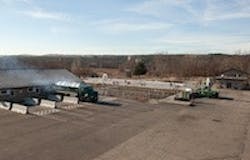Ballasted Biological System Helps Allentown Out of a Jam
A new ballasted biological treatment process helped the Allenstown, N.H. Wastewater Treatment Plant expand capacity in response to orders from state regulators who had placed a moratorium on new sewer hookups.
The lower cost of the new process enabled the plant to make the improvements in the first place, because ratepayers had voted down previous bonding proposals to expand the facility. The new technology also allows the plant to achieve complete nitrification.
The Allentown facility serves two municipalities with a combined population of 15,000. The original plant was designed 30 years ago as an extended aeration activated sludge process with 1.05 million gal capacity. However, it has always operated as a conventional activated sludge process without primary clarifiers. Raw wastewater passes through a headworks facility, then to aeration, clarification and finally chlorine disinfection.
Beyond Capacity
Although the communities’ sewers are not combined, infiltration and inflow was contributing to serious wet-weather capacity issues. In 2005, the state Department of Environmental Services found that the plant was exceeding capacity and placed a moratorium on sewer connections. The utility sought design recommendations from consultant Hoyle, Tanner Associates (HTA). The firm proposed a comprehensive plant upgrade including sequencing batch reactors, but voters twice rejected a proposed bond issue because of the project’s high cost. Essentially, ratepayers said they were not willing to spend a nickel on the expansion.
Unable to get voters to approve a full plant upgrade, the sewer commission asked HTA to find a Plan B. The firm recommended installing the BioMag ballasted biological treatment system from Evoqua Water Technologies.
Even though it cost one-tenth of the earlier proposal, voters again said no. Eventually, the commission worked out a funding plan, using revenue from the plant’s treatment of statewide seepage along with federal funds from the American Recovery and Reinvestment Act (ARRA), funneled through the New Hampshire state revolving loan fund.
Since 2005, septage treatment fees had added enough to the utility’s capital reserves to support half of the $1.6 million project. Fifty percent principal forgiveness allowed by the state from ARRA funding enabled the project to be done at no cost to ratepayers or taxpayers, who then approved the project.
The System
The BioMag system adds magnetite to conventional biological floc to make it heavier, improving settling rates and increasing secondary biological clarifier performance without the addition of capital-intensive new tankage. It has proven effective where clarifiers are the choke point in wastewater treatment plants.
The magnetite is stored on site, then blended into a sidestream of waste activated sludge (WAS) and fed directly into the bioreactor, where it is gently mixed and fully infused with the contents. As the specific gravity of the flock increases, biological solids settle faster and more reliably, resulting in extremely low clarifier sludge blankets.
The mixed liquor suspended solids concentration increases without risk of upset, and the clarifier easily handles the increased solids loading rate. As a result, operators gain more control over sludge blankets, especially during storms, and tank capacity can be freed up for nutrient removal.
Improved Settling
The new process went online in February 2011, about the same time the plant staff made other modifications that included converting the extended aeration process to a Modified Ludzack-Ettinger (MLE) process. The operations staff worked closely with HTA and Evoqua to install and start up the BioMag system. Since it was a relatively new process, each group learned from the experience. Different parameters need to be monitored with a ballasted aeration basin and clarifier, especially the amount of magnetite in the system and the magnetite recovery rates.
The issue of settling became a thing of the past as the BioMag system increased specific gravity of the biological floc and essentially took the settling issue out of the equation. The plant’s 7-ft-deep clarifiers had been challenged in wet-weather conditions, but with ballasted solids, the plant can now handle a peak hourly flow five times the design flow while maintaining a steady sludge blanket.
The MLE and BioMag system improvements also enabled the plant to nitrify. Before the BioMag system, the plant could not fully nitrify because of inadequate solids retention time (SRT). Now, the plant easily achieves the SRT needed for complete nitrification with a high mixed liquor solids concentration because the clarifiers perform reliably and can handle the higher solids loading. The plant now achieves complete nitrification year-round.
Recovering Magnetite Ballast
The treatment plant recovers about 95% of the magnetite for reuse. The rest ends up in the biosolids, increasing the iron content slightly. Solids wasted from the treatment process are dewatered on a screw press, combined with septage and landfilled. The plant effluent meets BOD and TSS limits of 30 mg/L for release to the Merrimack River. While the state has not yet set new mass loading requirements, the plant’s next permit most likely will require reductions in effluent concentrations as capacity increases. That, plus anticipated requirements on ammonia, phosphorus and copper will make the BioMag system and its ability to stabilize the process and improve effluent quality even more critical to plant performance. In sum, the plant staff and management can sleep better at night.
Jim Force is a freelance writer on water and wastewater topics, based in Wausau, Wis. For questions, please contact Casey Whittier, product manager with Evoqua Water Technologies at [email protected] or 262.521.8506.
